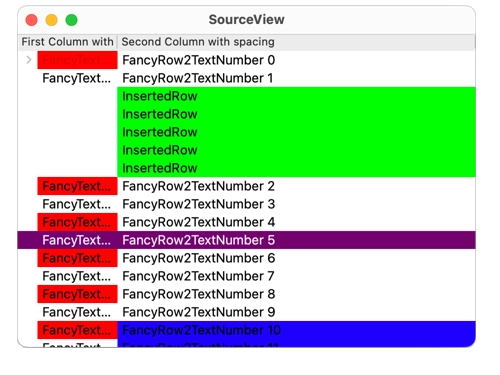使用非 QIODevice -based transport (QWebSocket) with QtRemoteObjects .
This example shares a
QStandardItemModel
over a web socket. The model can be edited in the window of the
wsserver
application, and the changes are propagated to the window of the
wsclient
应用程序。
This is made possible by implementing a small
QIODevice
-derived wrapper,
WebSocketIoDevice
, for
QWebSocket
. SSL is used if Qt is compiled with support for it.

The
wsserver
application creates a
QStandardItemModel
with two columns and inserts data into it.
int main(int argc, char *argv[]) { QLoggingCategory::setFilterRules("qt.remoteobjects.debug=false\n" "qt.remoteobjects.warning=false"); QApplication app(argc, argv); const int modelSize = 100000; QStringList list; QStandardItemModel sourceModel; QStringList hHeaderList; hHeaderList << QStringLiteral("First Column with spacing") << QStringLiteral("Second Column with spacing"); sourceModel.setHorizontalHeaderLabels(hHeaderList); list.reserve(modelSize); for (int i = 0; i < modelSize; ++i) { QStandardItem *firstItem = new QStandardItem(QStringLiteral("FancyTextNumber %1").arg(i)); if (i == 0) firstItem->appendRow(addChild(2, 2)); QStandardItem *secondItem = new QStandardItem(QStringLiteral("FancyRow2TextNumber %1").arg(i)); if (i % 2 == 0) firstItem->setBackground(Qt::red); QList<QStandardItem*> row; row << firstItem << secondItem; sourceModel.invisibleRootItem()->appendRow(row); //sourceModel.appendRow(row); list << QStringLiteral("FancyTextNumber %1").arg(i); }
It then starts a
QWebSocketServer
bound to port 8088, and hosts the data model.
QWebSocketServer webSockServer{QStringLiteral("WS QtRO"), QWebSocketServer::NonSecureMode}; webSockServer.listen(QHostAddress::Any, 8088); QRemoteObjectHost hostNode; hostNode.setHostUrl(webSockServer.serverAddress().toString(), QRemoteObjectHost::AllowExternalRegistration); hostNode.enableRemoting(&sourceModel, QStringLiteral("RemoteModel"), roles);
When handling new connections, SSL is configured if Qt is compiled with support for it. Then a
WebSocketIoDevice
is created using the incoming WebSocketServer connection.
QObject::connect(&webSockServer, &QWebSocketServer::newConnection, &hostNode, [&hostNode, &webSockServer]{ while (auto conn = webSockServer.nextPendingConnection()) { #ifndef QT_NO_SSL // Always use secure connections when available QSslConfiguration sslConf; QFile certFile(QStringLiteral(":/sslcert/server.crt")); if (!certFile.open(QIODevice::ReadOnly)) qFatal("Can't open client.crt file"); sslConf.setLocalCertificate(QSslCertificate{certFile.readAll()}); QFile keyFile(QStringLiteral(":/sslcert/server.key")); if (!keyFile.open(QIODevice::ReadOnly)) qFatal("Can't open client.key file"); sslConf.setPrivateKey(QSslKey{keyFile.readAll(), QSsl::Rsa}); sslConf.setPeerVerifyMode(QSslSocket::VerifyPeer); conn->setSslConfiguration(sslConf); QObject::connect(conn, &QWebSocket::sslErrors, conn, &QWebSocket::deleteLater); #endif QObject::connect(conn, &QWebSocket::disconnected, conn, &QWebSocket::deleteLater); QObject::connect(conn, &QWebSocket::errorOccurred, conn, &QWebSocket::deleteLater); auto ioDevice = new WebSocketIoDevice(conn); QObject::connect(conn, &QWebSocket::destroyed, ioDevice, &WebSocketIoDevice::deleteLater); hostNode.addHostSideConnection(ioDevice); } });
A QTreeView is created with the QStandardItemModel as model. Then multiple timers are started with QTimer::singleShot to perform more modifications to the model.
QTreeView view; view.setWindowTitle(QStringLiteral("SourceView")); view.setModel(&sourceModel); view.show(); TimerHandler handler; handler.model = &sourceModel; QTimer::singleShot(5000, &handler, &TimerHandler::changeData); QTimer::singleShot(10000, &handler, &TimerHandler::insertData); QTimer::singleShot(11000, &handler, &TimerHandler::changeFlags); QTimer::singleShot(12000, &handler, &TimerHandler::removeData); QTimer::singleShot(13000, &handler, &TimerHandler::moveData); return app.exec();
The
wsclient
application creates a QWebSocket and a
WebSocketIoDevice
taking it as an argument.
QScopedPointer<QWebSocket> webSocket{new QWebSocket}; WebSocketIoDevice socket(webSocket.data());
If Qt is compiled with support for SSL, the client is configured with it.
#ifndef QT_NO_SSL // Always use secure connections when available QSslConfiguration sslConf; QFile certFile(QStringLiteral(":/sslcert/client.crt")); if (!certFile.open(QIODevice::ReadOnly)) qFatal("Can't open client.crt file"); sslConf.setLocalCertificate(QSslCertificate{certFile.readAll()}); QFile keyFile(QStringLiteral(":/sslcert/client.key")); if (!keyFile.open(QIODevice::ReadOnly)) qFatal("Can't open client.key file"); sslConf.setPrivateKey(QSslKey{keyFile.readAll(), QSsl::Rsa}); sslConf.setPeerVerifyMode(QSslSocket::VerifyPeer); webSocket->setSslConfiguration(sslConf); #endif
Then a
QRemoteObjectNode
is created, and setup to use the WebSocketIoDevice. Then it connects to
wsserver
.
QRemoteObjectNode node; node.addClientSideConnection(&socket); node.setHeartbeatInterval(1000); webSocket->open(QStringLiteral("ws://localhost:8088"));
A QTreeView is created to display the data from the server. The model is acquired from the node, and it is then set as the model of the QTreeView, which is then shown.
QTreeView view; view.setWindowTitle(QStringLiteral("RemoteView")); view.resize(640,480); QScopedPointer<QAbstractItemModelReplica> model(node.acquireModel(QStringLiteral("RemoteModel"))); view.setModel(model.data()); view.show(); return app.exec();